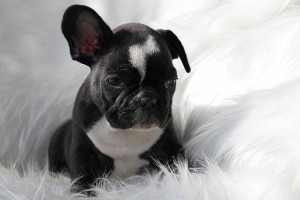How To Train Your Puppy – eBook Chapter 2
Housebreaking Your Puppy
If you choose to do nothing else in training your dog…housebreaking is THE MOST IMPORTANT ASPECT OF TRAINING AND IT MUST BE DONE! Dogs aren’t able to tell the difference between the foot of your bed and the back yard when it comes to using the bathroom. According to an untrained dog, there aren’t many places that they wouldn’t want to use for a bathroom. Potty training your pup should be relatively simple if you are willing to follow the steps outlined in this eBook.
As the potty training begins, you will probably need to distance yourself from your pup as being the cuddly human they love so much. In order to successfully housebreak a puppy, the dog must be confined to a small area in the home. Please don’t confuse small area as your lap on the couch! This might seem like a mean thing to do, but it’s important to realize that dogs were once den dwellers. They quite enjoy being in a crate or dog house as it makes them feel secure (so long as you get them used to the confinement as a young puppy.) Dogs are also imprinted to want to be praised, so by training them you will be able to give them the praise that they desperately want.
Puppy Housebreaking Step-by-Step
- Locate a crate or kennel for your new puppy. When you are not actively engaged with the dog through walking or playing they should be confined to this crate. The confinement includes overnight and when the puppy is home alone. The puppy should learn not to expect or to be give free run in your home until the dog is completely trained because it gives them a false sense of dominance and will ultimately make it much harder to train the dog. Also, most dogs will never eliminate in their kennels, so you are reducing the risk of an accident in the house. The crate must be large enough for the dog to sit in, stand up in, turn around in, and lay down in. A crate that is too large for your dog will not make them feel secure and a crate that is too small will be uncomfortable. Since the puppy will grow into a dog, you will eventually need to invest in a larger crate. If you maintain your dogs crate, selling it online should be no problem.
- You need to plan to have someone around the puppy most of the time. Do not bring your puppy home the day before you leave on a vacation. The best time to bring a new puppy into your home is on a Friday evening so that you have two full days to spend in direct contact with the dog. This will help jump-start your housebreaking efforts.
- Purchase some training supplies. You need to procure lots of treats for potty and other behavioral training. You should have a wide variety of treats that are safe for puppies to chew. You can also purchase regular size treats and cut them up into small training rewards. There are treat bags you can get that clip onto your belt or on the side of your pocket, but a sandwich bag will work just as well. Don’t leave the treats loose in your pocket, because the dog will smell them and won’t ever leave you alone.
- When it comes to potty training you will need to use a stopwatch or a timer. If you own a small dog or live in an apartment, you may opt to use pee pee pads. If you are opposed to the pee pee pads, there are grass beds available as well. These are good choices if you live in an apartment or training your dog to relieve on the balcony. If your puppy will one day grow up to be a large dog, the pee pee pads or grass bed is not a viable solution.
- Come up with a schedule and STICK TO IT! The general rule states that puppies can hold their urine for one hour for every month of age plus one hour. For example, if your dog is two months old, he should be able to hold it for three hours. However, this doesn’t mean that you should wait three hours before taking them out. You should start feeding and watering the puppy at the same time every day. Your dog will let you know which it prefers. Every time you feed the puppy, place the food where the puppy can access it and leave it there for fifteen minutes to one half hour. After that the food should be taken away until the next feeding. This prevents your puppy from getting off schedule with feedings and elimination.
- After your puppy eats, you must take him immediately to the place in the yard where you wish it to potty. YOU must choose the area of your lawn that you want the puppy to associate as the toilet and place him in that area. Walk the puppy around the designated potty area and use a verbal cue that you will remember like “Go Potty” or “Get Busy.” These cues will become clear to the puppy and they will react to them throughout their life. Make sure everyone in your household who will be taking out the puppy for elimination know to use the same verbal cue.
- Keep using your verbal cues while the puppy goes potty. Once they are done praise him with affection and a small treat. If they don’t eliminate within five minutes take the dog back inside and put them in their crate. Wait another fifteen minutes and try the process again until you are successful.
- Throughout the day the potty process needs to be repeated. Once an hour is best even if the puppy has not consumed any food or water. Each time the puppy eliminates you must praise him with affection and a treat. Also, the puppy should be allowed some supervised play time once brought back in the house.
- At bedtime the puppy must be kept in the kennel. We know that it’s hard to resist cuddling in bed with your sweet puppy, but this absolutely must not be done. More often than not, you will wake up with puppy urine soaked sheets. You can, however, move the kennel into your bedroom at night to satisfy both you and the puppy’s desire to be near each other. Do NOT feed or water puppy near bedtime and try for a successful elimination before placing the pup in the crate for the night. When the puppy is very small, it may be necessary to set an alarm to awake you at least once per night to take the puppy out for elimination.
This is a solid housebreaking plan that should work for anyone when implemented properly. You should be able to train your puppy within just a few days of this method. If you are still having problems you may need to adjust your schedule so that it better suits the needs of your puppy. Remember that even the best trained dogs have accidents when they are young, so patience is the most important tool at your disposal. Keep a hefty supply of carpet cleaner on hand to take care of any accidents. Also, it is very important not to scold or yell at your puppy for accidents. Ultimately, all your puppy wants is your love and approval. The more positive reinforcement you can give them for doing things the way you want them to be done, the more the puppy will perform the rewarded behaviors in a positive manner.
…Stay tuned for chapter 3 “Kennel Training Your Puppy”


